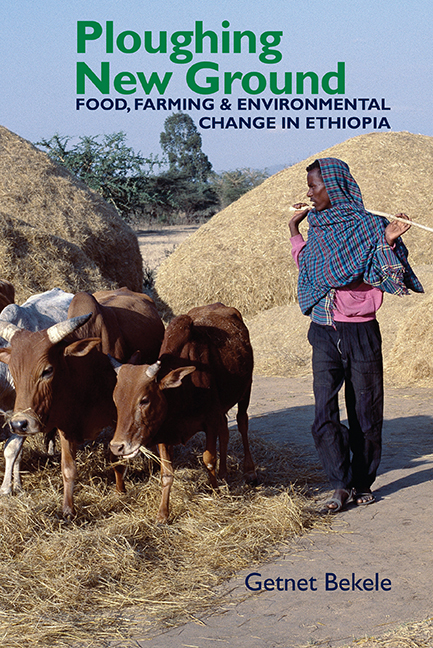Book contents
- Frontmatter
- Dedication
- Contents
- List of Maps and Tables
- Acknowledgements
- Note on Orthography
- Acronyms & Abbreviations
- Glossary
- Map
- Introduction
- 1 Landscape Pastoral: The making and remaking of a grassland environment, 1886–1916
- 2 Negotiating a Landscape: Continuity and change in a grassland environment, 1917–1941
- 3 Blurring the Boundaries: The ascendancy of crop production in a flexible environment, 1942–1955
- 4 Fresh Encounters and Morphing Strategies: The changing organization of production in an era of agricultural intervention, 1956–1965
- 5 Inputs, Outputs and the Farm: Transformations in the science, politics and praxis of agricultural development, 1966–1974
- 6 Competition and Co–existence: Creating space for small- to large-scale farming, 1966-1974
- 7 Of Production and Production Relations: Farming in an era of revolutionary change and socialist development, 1975–1991
- 8 Vicious Circle: Agricultural development at the time of ‘revolutionary democracy’, 1991–2016
- Conclusion
- Bibliography
- Index
- Eastern African Studies
- Frontmatter
- Dedication
- Contents
- List of Maps and Tables
- Acknowledgements
- Note on Orthography
- Acronyms & Abbreviations
- Glossary
- Map
- Introduction
- 1 Landscape Pastoral: The making and remaking of a grassland environment, 1886–1916
- 2 Negotiating a Landscape: Continuity and change in a grassland environment, 1917–1941
- 3 Blurring the Boundaries: The ascendancy of crop production in a flexible environment, 1942–1955
- 4 Fresh Encounters and Morphing Strategies: The changing organization of production in an era of agricultural intervention, 1956–1965
- 5 Inputs, Outputs and the Farm: Transformations in the science, politics and praxis of agricultural development, 1966–1974
- 6 Competition and Co–existence: Creating space for small- to large-scale farming, 1966-1974
- 7 Of Production and Production Relations: Farming in an era of revolutionary change and socialist development, 1975–1991
- 8 Vicious Circle: Agricultural development at the time of ‘revolutionary democracy’, 1991–2016
- Conclusion
- Bibliography
- Index
- Eastern African Studies
Summary
Has Ethiopia become all of a sudden the next legible frontier of ‘agroimperialism’? The American journalist and writer Andrew Rice seems to think that way. In a scintillating article that he published in 2009, Rice, like many after him, revealed how: ‘Fearing food shortages, investors from Saudi Arabia and other wealthy countries are snapping up land in poor countries like Ethiopia in order to grow food there’ and ship it back home in large quantities. They wondered if such practices amounted to ‘neocolonialism’ or ‘development’? If the majority of the studies that invoked that binary tended to focus on global, macropolitical and macroeconomic issues, what concerned other groups of writers and critiques, including the internationally active rights groups such as GRAIN and the Oakland Institute, was the threats that the resultant practices, most notably the proliferation of large-scale land acquisitions (LSLAs) and large-scale commercial farming pose on the micro-environment and the livelihood practices of ‘indigenous’ populations. Consequently, they presented evidence and arguments contradicting the official Ethiopian government and World Bank view that exaggerated the virtues and potential of largescale commercial farming.
To be sure, there is nothing sui generis or unprecedented in the ruling Ethiopian People's Revolutionary Democratic Front (EPRDF)'s policy on large-scale commercial farming. Aside from being a global phenomenon, the theory and practice of large-scale commercial farming has also a relatively long, albeit convoluted, history in Ethiopia, one that can be traced back to the first three decades of the twentieth century. Yet, what is remarkable about that history is not its longevity. It is, rather, largescale commercial farming's inability to thrive, endure and become a viable undertaking in Ethiopia during in the twentieth century that is remarkable. On the contrary, smallholder agriculture has proved to be the most durable, most versatile and socially most sustainable sector in Ethiopia all along. In addition, smallholder agriculture has rendered meaning and direction to the science, politics and practice of agricultural development in Ethiopia for most of its history. Strikingly, these were the trends and the realities that EPRDF has sought to occlude, reverse and alter drastically when it made the decision to pivot large-scale commercial farming as the epitome of its so-called Agricultural Development-led Industrialization programme (ADLI) in 2008.
- Type
- Chapter
- Information
- Ploughing New GroundFood, Farming & Environmental Change in Ethiopia, pp. 1 - 21Publisher: Boydell & BrewerPrint publication year: 2017

